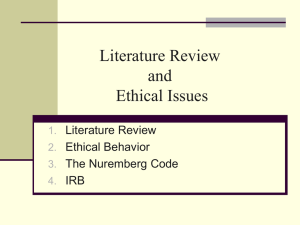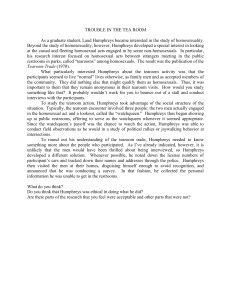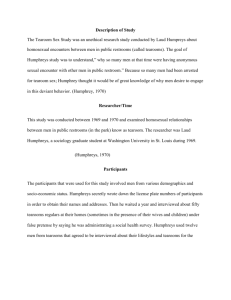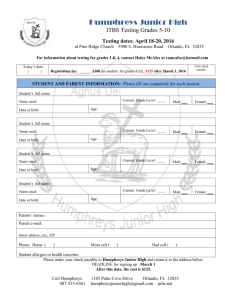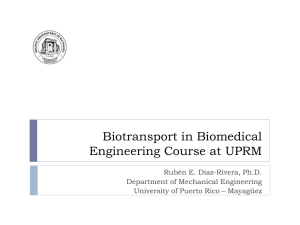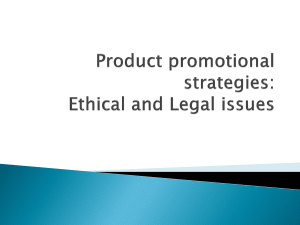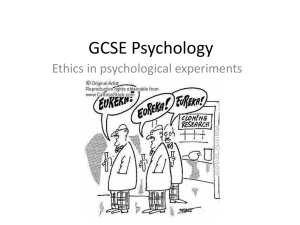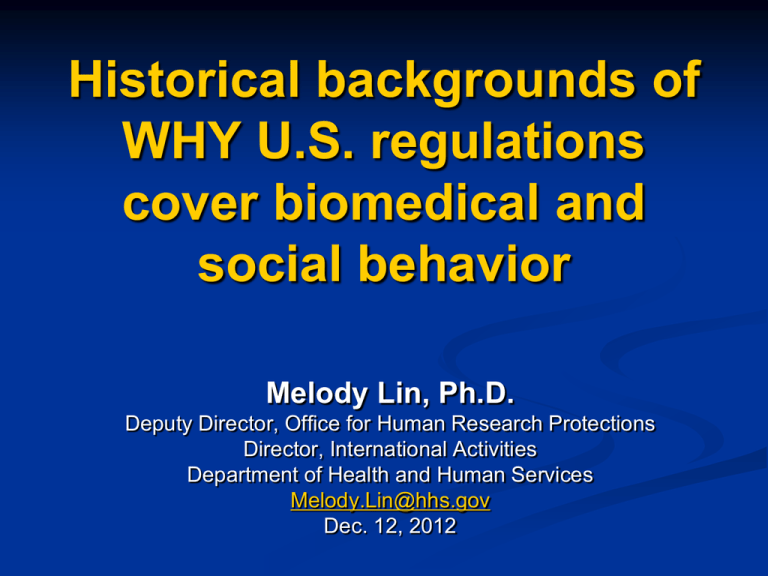
Historical backgrounds of
WHY U.S. regulations
cover biomedical and
social behavior
Melody Lin, Ph.D.
Deputy Director, Office for Human Research Protections
Director, International Activities
Department of Health and Human Services
Melody.Lin@hhs.gov
Dec. 12, 2012
Objectives
Historical cases of unethical research
National Research Act
National Commission
Biomedical
Behavioral
Nuremberg
23 German doctors were
charged with crimes
against humanity
experiments without subject consent
The Nuremberg Code (1947)
Rules for "Permissible Medical Experiments"
voluntary consent
benefits outweigh risks
withdraw from participation
Nuremberg Code
Informed consent without coercion
Prior animal experimentation
Justify by anticipated scientific results
Qualified scientists
Avoid physical and mental suffering
No expectation of death or disabling injury
Did the Nuremberg Code
Impact the behavior of
American scientists who did
research on humans?
No
But, in America
Willowbrook (1950s)
Mentally retarded children were deliberately injected
with hepatitis virus to study its effects
Jewish Chronic Disease Hospital (1960s)
Live cancer cells were injected into 22 senile patients.
… with no benefit to patients,
and no consent of kin.
The 18th World Medical
Assembly (1964), in the
Declaration of Helsinki
Set forth additional recommendations to
guide medical doctors in biomedical
research involving human subjects
Beecher Article
“Ethics and Clinical Research”
Henry K. Beecher
New Engl J Med 274 (1966):1354-60
22 published medical studies presenting risk to
subjects without their knowledge or approval
Published in some of the most prestigious
journals and conducted at some of the most
prestigious institutions
Tuskegee Syphilis Study
PHS conducted 1932-1972
400 Black American Men
Natural course of untreated syphilis
Unknowing participants
No treatment when drugs were available
National Action
1973 - Kennedy Hearings. Tuskegee, etc., and ta
search for ethical issues in social/behavioral
research:
Stanley Milgram’s Obedience Study
Laud Humphreys’ Study of “tearoom trade”
1974 - National Research Act established the
National Commission for Protection of Human
Subjects of Biomedical & Behavioral Research
Required IRBs at institutions receiving HEW
support for human subjects research.
The Belmont Report
Ethical Principles and Guidelines for the Protection
of Human Subjects of Research
Respect for persons
Beneficence
Justice
National Commission for the Protection of Human
Subjects of Biomedical and Behavioral Research,
1979
The Milgram Study
1961
Psychologist, Yale Univ.
The Milgram Study
Experiment on obedience to authority figures
Study on the conflict between obedience
toward authority and ones personal
conscious
E – Experimenter
T – Teacher (Subject)
L – Learner (Actor)
(E) orders (T) to give what
the subject believes are
painful electric shocks to (L).
The subjects (T) believed that
for each wrong answer, the (L)
was receiving actual shocks,
but in reality there were no
shocks.
(L) set up a tape recorder
integrated with the electroshock generator, which
played pre-recorded sounds
for each shock level.
The Milgram Study
Only the "teacher" is an actual subject,
i.e. unaware about the actual setup
The subject and the learner were told by
the experimenter that they would be
participating in an experiment helping
his study of memory and learning in
different situations
The Milgram Study: Results
In the first set of experiments, 65 percent
of the subjects administered the
experiment's final massive 450-volt shock
many were very uncomfortable doing so;
some said they would refund the money they
were paid for participating in the experiment
Ethical Issues
Respect for Persons: Stanley Milgram deceived
his study's subjects (failure to disclose important
aspects of study to allow a voluntary decision to
participate)
Beneficence: Subjects (T) were placed under
more pressure than many believe was
necessary to test the study hypothesis
Respect for Persons: Subjects were coerced into
remaining in study against their will
Humphreys: Tearoom Trade
Ph.D. dissertation (sexual) Deviance
Sociologist, Wash. U.
Laud Humphreys studied homosexual
encounters in “tearooms” – public
restrooms
Homosexuals who engage in sex in
tearooms like to have a third person
present, someone they call a “Watch
queen”
Humphreys (cont’d)
As a “Watch Queen” Humphreys made
observations in order to do research
He wrote down the license plate numbers
of the men and traced their home
addresses
A year later, he visited them at home, and
conducted a follow-up survey
Humphreys (cont’d)
38% of men having tearoom sex were
married
Most identified themselves as
heterosexual
It turns out, most of these men were
frustrated their wives
Ethical issues
The researcher acted as a lookout, alerting
participants engaged in an illegal activity
Unknown to the subjects, the researcher noted
the license numbers of their cars
License numbers were traced to reveal the
name and address of each car owner
Traced subjects were interviewed as part of a
larger public health survey (true purpose of their
participation not revealed)
Ethical Problems
Aiding in crime
Since the Missouri law forbade homosexual
activity Humphreys was assisting in a crime
by acting as a lookout (i.e., the “watch queen”)
Ethical Problems (cont’d)
Informed consent
Did not seek informed consent
Likely they would have refused participation
Endangering subjects
Took some care here: the names in safety
deposit box in another state, refusing to tell
police what he was doing
What if name had been released?
Would the publication lead to a “crack down”?
Laud Humpheys’ Postscript
Because of his study, the sociology
department lost federal funding, many
senior faculty left
Sociology program later eliminated
Laud Humphreys (1930-1988) received his
Ph.D. Career SUNY (Albany, NY)
Summary
National Research Act. 1974
Federal response to harm arising from
biomedical and behavioral experimentations
National commission for the protection of human
subjects of biomedical and behavioral research
National commission outlined ethical principals
upon which the ethics of research study are
evaluated in the U.S.

